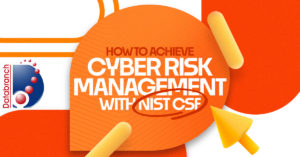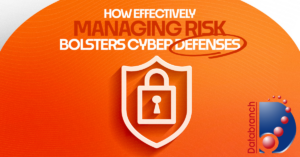
Keeping sensitive data and critical tech safe from cyberattacks is crucial for businesses like yours. Your survival and growth depend on how well your organization can withstand cyberthreats. That’s where cyber risk management comes into play.
Businesses with solid cyber risk management strategies can build formidable cyber defenses and reduce risks without compromising business growth. Besides enhancing security, it also ensures your business stays compliant.
In this blog, we’ll share the core principles of cyber risk management and show you how integrating it with a simple but effective security framework can help you achieve strategic success.
Key Characteristics of Risk-Based Cybersecurity
Risk-based cybersecurity helps organizations focus their efforts and resources on the most critical risks. This approach aims to reduce vulnerabilities, safeguard what matters most to you and ensure you make informed decisions.
Here are the key characteristics of risk-based cybersecurity:
Risk reduction: By proactively identifying and neutralizing threats, you can reduce and minimize the potential impact of a cyber incident.
Prioritized investment: By identifying and assessing risks, you can concentrate your investment efforts on areas that need your attention most.
Addressing critical risks: Dealing with the most severe vulnerabilities first can help you strengthen your business security. That is why it is important to conduct vulnerability assessments regularly, at least every quarter if not more frequently.
All Databranch Comprehensive Care and Foundation Security clients have scheduled automatic patching and Windows updates on their devices to assist with vulnerability management. Visit us here to learn how we can help take this off your IT plate.
Cyber Risk Management Frameworks
Cybersecurity risk frameworks act as a guide that helps businesses achieve the full potential of a risk-based approach. Here are several ways frameworks can help you enhance your current cybersecurity posture:
- Takes away the guesswork and give businesses a structured way to assess their current cybersecurity posture.
- Helps organizations systematically focus their investments on addressing the most critical and relevant risks.
- Provides organizations with the right guidance that helps build security, which is crucial for building customer trust.
- Are built using controls that have been tried and tested. They essentially help businesses implement effective security controls.
- Designed to help organizations achieve compliance with government and industry regulations.
NIST Cybersecurity Framework
The National Institute of Standards and Technology Cybersecurity Framework (NIST CSF) is a popular, user-friendly framework that empowers business leaders like you to boost organizational cybersecurity. Think of it as a valuable tool created by top security experts to help you protect and secure your digital assets.
Here’s how the NIST CSF supports a risk-based approach:
- It helps you understand your risk by identifying what is most valuable to you.
- It gives you a high view of people, processes, technology, information and other business-critical aspects that need to be secured from threats so your business can operate successfully.
- It helps you prioritize your risks based on their impact on your business.
- It helps you allocate your resources where they matter most and ensures you maximize your investment.
- It promotes continuous monitoring and helps you adapt to evolving threats.
Secure your Future
Safeguarding your business from cyberthreats is critical for the survival and growth of your business. Don’t leave your business security to chance. Partnering with Databranch as your managed IT provider, means your business will have the security of knowing that your network is being monitored and maintained on a 24/7 basis.
Download our infographic, “Assess Your Cyber-Risks in 7 Critical Steps,” and strengthen your defenses against lurking cyber dangers.
Read More

In today’s rapidly evolving digital landscape, where cyberthreats and vulnerabilities continually emerge, it’s obvious that eliminating all risk is impossible. Yet, there’s a powerful strategy that can help address your organization’s most critical security gaps, threats and vulnerabilities — comprehensive cyber risk management.
Implementing a well-thought-out cyber risk management strategy can significantly reduce overall risks and strengthen your cyber defenses. To understand the profound impact of this approach, continue reading as we delve into the nuances that make it a game changer in digital security.
Cyber Risk Management vs. Traditional Approaches
Cyber risk management diverges significantly from traditional approaches, differing in the following key aspects:
Comprehensive Approach
Cyber risk management isn’t just an additional layer of security. It’s a comprehensive approach that integrates risk identification, assessment and mitigation into your decision-making process. This ensures there are no gaps that could later jeopardize your operations.
Beyond Technical Controls
Unlike traditional approaches that often focus solely on technical controls and defenses, cyber risk management takes a broader perspective. It considers various organizational factors, including the cybersecurity culture, business processes and data management practices, ensuring a more encompassing and adaptive security strategy.
Risk-Based Decision-Making
In traditional cybersecurity, technical measures are frequently deployed without clear links to specific risks. Cyber risk management, however, adopts a risk-based approach. It involves Threat Modeling, which is a deep analysis of potential threats, their impact, and likelihood.
Threat modeling helps businesses prioritize their risk management and mitigation strategies. The goal is to mitigate the risk of falling victim to a costly cyber incident
Alignment with Business Objectives
A distinctive feature of cyber risk management is its alignment with your overarching business objectives. It ensures that your cybersecurity strategy takes into account your mission, goals and critical assets, thereby making it more relevant to your organization’s success.
Holistic View of Security
Cyber risk management recognizes the significance of people, processes and technology, embracing a holistic view of security. It acknowledges that a robust security strategy is not solely dependent on technology but also on the people implementing it and the processes that guide its deployment.
This is why Employee Security Awareness training can make such an impact on your businesses cybersecurity posture. You and your colleagues are your company’s greatest risk, but also your greatest asset. Visit us here to learn more about our advanced cybersecurity training program.
Resource Allocation
By prioritizing risks based on their potential impact and likelihood, cyber risk management allows you to allocate resources more effectively. This means that your organization can focus on the areas of cybersecurity that matter the most, optimizing resource utilization.
The Role of Risk Tolerance in Cyber Risk Management
Risk tolerance is a pivotal aspect of enterprise risk management (ERM). It serves as a guiding principle, shaping your organization’s risk-taking behavior, influencing decision-making and providing a framework for achieving objectives while maintaining an acceptable level of risk.
Key components of risk tolerance are:
Willingness to Take Risks
Risk tolerance in cyber risk management is about your organization’s readiness to embrace calculated risks by acknowledging that not all risks can be eliminated. It shapes your organization’s ability to innovate and seize opportunities while maintaining an acceptable level of security risk.
The Capacity to Absorb Losses
This component of risk tolerance assesses your organization’s financial resilience. It’s about having a financial buffer to absorb losses without jeopardizing your core operations, ensuring that you can recover from security incidents without severe disruption.
Consideration of Strategic Objectives and Long-Term Goals
Risk tolerance should be in harmony with your strategic objectives and long-term goals. It ensures that your risk-taking behavior is aligned with your organization’s broader mission, avoiding actions that could undermine your strategic direction.
Visit us here to learn more about how to conduct a Technology Infrastructure Review and how to incorporate the results into your IT objectives roadmap.
Compliance and Regulatory Considerations
Meeting compliance and regulatory requirements is an essential aspect of risk tolerance. It means understanding the legal and regulatory landscape and ensuring that your risk management strategy adheres to these standards, reducing the risk of legal consequences.
Meeting the Expectations of Customers and Stakeholders
A critical part of risk tolerance is understanding and meeting the expectations of your customers and stakeholders. It involves maintaining the trust and confidence of these groups by demonstrating that you prioritize their interests and data security in your risk management approach.
Collaborative Path to Success
Now that you understand how cyber risk management empowers organizations like yours to strengthen your defenses, it’s time to take action. Download our comprehensive checklist to navigate the four essential stages of cyber risk management. This resource will guide you in implementing a tailored strategy that meets your unique needs.
Don’t wait for the next cyberthreat to strike. Reach out to Databranch today at 716-373-4467 option 6, or [email protected] to start the process of making your organization more secure. Together, we’ll enhance your digital defenses, secure your organization’s future and prioritize your security.
Read More

Cybersecurity is an essential aspect of any business or organization. As technology evolves, so do the threats that can harm an organization’s operations, data and reputation. One of the most effective ways to defend against these threats is through the Defense in Depth (DiD) approach.
DiD is a cybersecurity approach in which multiple defensive methods are layered to protect a business. Since no individual security measure is guaranteed to endure every attack, combining several layers of security is more effective.
This layering approach was first conceived by the National Security Agency (NSA) and is inspired by a military tactic with the same name. In the military, layers of defense help buy time.
However, in IT, this approach is intended to prevent an incident altogether.
Essential Elements of DiD
Implementing all the elements of an effective DiD strategy can help minimize the chances of threats seeping through the cracks. These elements include:
1. Firewalls
A firewall is a security system comprised of hardware or software that can protect your network by filtering out unnecessary traffic and blocking unauthorized access to your data.
2. Intrusion Prevention and Detection Systems
Intrusion prevention and detection systems scan the network to look for anything out of place. If a threatening activity is detected, it will alert the stakeholders and block attacks.
3. Endpoint Detection and Response (EDR)
Endpoint detection and response (EDR) solutions constantly monitor endpoints to find suspicious or malicious behavior in real time.
Databranch is excited to announce a new detection software that we have begun implementing for our clients. The Huntress Managed Detection and Response (MDR) for Microsoft 365 secures your users with 24/7 protection.
Huntress MDR can detect and respond to early signs of cyberattacks such as unauthorized access, email manipulation, and suspicious login locations.
The software then utilizes Huntress’s 24/7 Security Operations Center (SOC) which is comprised of experts who analyze and interpret the threats. An actual Huntress employee will review these detections, provide incident reports, and will deliver actionable remediations for recovery.
4. Network Segmentation
Once you divide your business’s network into smaller units, you can monitor data traffic between segments and safeguard them from one another.
5. The Principle of Least Privilege (PoLP)
The principle of least privilege (PoLP) is a cybersecurity concept in which a user is only granted the minimum levels of access/permissions essential to perform their task.
Visit us here to learn more about the risks associated with Local Administrative Privileges.
6. Strong Passwords
Poor password hygiene, including default passwords like “1234” or “admin,” can put your business at risk. Equally risky is the habit of using the same passwords for multiple accounts.
To protect your accounts from being hacked, it’s essential to have strong passwords and an added layer of protection by using practices such as Multi-Factor Authentication (MFA).
7. Patch Management
Security gaps left unattended due to poor patch management can make your business vulnerable to cyberattacks. When a new patch is delivered, deploy it immediately to prevent exploitation.
Databranch offers a Patch Management solution for our managed client’s that automates and manages service packs, hot-fixes, and patches from a single location.
How IT service providers help defend against threats
As a Databranch client, our experienced team members will help you divide DiD into three security control areas:
1. Administrative controls
The policies and procedures of a business fall under administrative controls. These controls ensure that appropriate guidance is available and security policies are followed.
Examples include hiring practices or employee onboarding protocols, data processing and management procedures, information security policies, vendor risk management and third-party risk management frameworks, information risk management strategies, and more.
3. Technical controls
Hardware or software intended to protect systems and resources fall under technical controls.
They include firewalls, configuration management, disk/data encryption, identity authentication (IAM), vulnerability scanners, patch management, virtual private networks (VPNs), intrusion detection systems (IDS), security awareness training and more.
4. Physical controls
Anything that physically limits or prevents IT system access falls under physical controls, such as fences, keycards/badges, CCTV systems, locker rooms and more.
Don’t worry if you are struggling with developing a DiD strategy for your organization. Databranch is here to make things as simple as possible. Contact us at 716-373-4467 option 6, or [email protected] to start the process of making your organization more secure.
Read More

Data loss disasters come in many forms, ranging from full-scale natural calamities to cyberattacks and even simple human errors. Disasters can bring businesses to a grinding halt. Apart from financial and reputational damage, failing to protect valuable data can also result in expensive lawsuits.
That’s why businesses, regardless of size, must have a backup and disaster recovery (BCDR) plan. By implementing a foolproof BCDR, you can quickly get your business back up and running should disaster strike. It will also help you comply with governmental and industry regulatory frameworks.
In this post, we’ll break down the different types of data loss disasters and outline the key BCDR components that can help you make it through a disruptive event with flying colors.
The Many Forms Data Loss Can Take
Let’s analyze the various types of data loss disasters that can hurt your business:
Natural Disasters
This covers everything from storms, hurricanes, floods, fires, tsunamis and volcano eruptions. In most cases, you can expect infrastructural damages, power failure and mechanical failures, which could then lead to data loss.
Hardware and Software Failure
Software and hardware disruption can cause data loss if you don’t have BCDR measures in place. These disruptions could be due to bugs, glitches, configuration errors, programmatic errors, component failures, or simply because the device is at its end of life or the software is outdated.
Unforeseen Circumstances
Data loss can happen due to random, unexpected scenarios. For instance, a portable hard disk held by an employee could get stolen, your server room may have a water leak because of a plumbing issue, or there could even be a pest infestation in one of your data centers.
Human Factor
Human errors are a leading cause of data loss incidents. These errors range from accidental file deletions, overwriting of existing files and naming convention errors to forgetting to save or back up data or spilling liquid on a storage device.
Cyberthreats
Your business may fall prey to malware, ransomware and virus attacks, which could leave your data and backups corrupt and irrecoverable. Additionally, data loss could be caused by malicious insiders with unauthorized access, which often goes under the radar.
Allowing your employees to have administrative privileges can leave holes in your cybersecurity, visit us here to learn more.
Key components of BCDR
Here are a few crucial things to keep in mind as you build a robust BCDR strategy:
Risk Assessment
Identify potential risks and threats that would impact business operations. Measure and quantify the risks to tackle them.
Databranch believes that identifying the right level of security to protect your IT infrastructure begins with a comprehensive security assessment that includes vulnerability/penetration evaluation, assessment reporting and security policy creation.
You can visit our website here to request your FREE baseline security assessment.
Business Impact Analysis (BIA)
Assess the potential consequences of a disruptive event on critical business functions and prioritize them in the recovery plan.
Continuity Planning
Implement procedures to resume critical business operations during disruption, with minimal downtime. Databranch offers our BCDR solution from Datto, the leader in Total Data Protection. Not only will Datto backup all your data to the device itself, but it will also backup everything to 2 separate offsite cloud storage locations.
So, in the event that the local device is destroyed, your business can be up and running in just minutes.
Disaster Recovery Planning
Plan a well-defined business resumption plan to recover critical IT functions and data following a disruptive incident. With a recovery plan in place, many businesses may simply never recover.
Do you know the cost of downtime for your business? If not, visit our website here to view our Recovery Time Calculator.
Testing and Maintenance
Periodically test your disaster recovery and backup plans to ensure they can be recovered in a disaster. If they fail, you can work on the enhancement.
Wondering Where to Begin?
Developing and implementing a BCDR plan on your own can be daunting. However, we can help you build the right BCDR strategy for your business profile.
Databranch has the knowledge and experience to take care of your backup and BCDR needs. Get in touch with us today at 716-373-4467 option 6, [email protected].
You can also download our infographic below to learn more about planning for potential data loss.
Read More

Even on a good day, being a business owner is challenging. Apart from dealing with and effectively solving multiple problems, you also need the foresight to arm your business with the right tools and solutions to tackle any issues that might arise later.
One issue you should always prioritize is data loss/data corruption and business disruption that cause downtime and productivity dips. Remember that data loss/data corruption and business disruption could happen due to various reasons, such as:
- Natural calamity
- Hardware failure
- Human error
- Software corruption
- Computer viruses
Adopting a comprehensive backup and business continuity and disaster recovery (BCDR) strategy is the best way to tackle this problem.
What is a comprehensive backup and BCDR strategy?
A comprehensive backup and BCDR strategy emphasizes the need for various technologies working together to deliver uptime. It even highlights technologies associated with cybersecurity. A robust strategy:
Protects All Systems, Devices and Workloads
Managing all systems, devices and workloads efficiently, securely and consistently can be challenging. Mistakes, errors, mishaps and outright failures across backup and recovery systems could happen at any time, leading to severe downtime or other costly business consequences.
That’s why it’s essential to have a reliable and secure solution to back up and protect business data as well as business systems, devices and workloads.
Ensures the Integrity, Availability and Accessibility of Data
The complexity of IT, network and data environments that include multiple sites — cloud, on-premises and remote — makes monitoring and protection difficult. It negatively affects the integrity, availability and accessibility of information and all IT network assets. That’s why it’s a best practice to simultaneously deploy tools or systems that cover all IT and network infrastructure (remote, cloud and on-site) with the same level of protection and security.
Enables Business Resilience and Continuity
A comprehensive and realistically achievable backup and BCDR strategy prioritizes, facilitates and ensures the continuity of business operations. It represents a business’ resiliency against downtime or data loss incidents.
Prioritizes Critical Protection and Security Requirements Against Internal and External Risks
No backup or BCDR solution can be effective if your business does not proactively identify and mitigate internal and external risks. You need tools that focus on internal and external threats through constant monitoring, alerting and tactical defense to empower your backup and BCDR strategy.
Databranch offers a suite of cost-effective computer managed services that proactively monitor and support your network and Technology infrastructure.
Optimizes and Reduces Storage Needs and Costs Through Deduplication
With the amount of data skyrocketing day after day, it poses serious storage and budgetary challenges for businesses. What makes things worse is the existence of multiple unnecessary copies of the same files.
Therefore, adopting the deduplication process can identify data repetition and ensure that no similar data is stored unnecessarily.
Manages Visibility and Unauthorized Access and Fulfills Data Retention Requirements
Your business data must never be visible to every employee in the same way. There must be policies and tools to ensure that an employee accesses only data essential to completing their tasks. Click here to reach more on the risks associated with Administrative Privileges.
Also, unauthorized access must be identified and blocked immediately. This is crucial not only for the success of backups and BCDR but also for maintaining compliance with all regulatory mandates related to data protection and retention.
Comprehensive Backup and BCDR for Your Business
By now, it must be clear to you that adopting a comprehensive backup and BCDR strategy is not an option but a necessity. An occasional, severe data loss incident or disruption could even open the gates for your competitors to eat into your profits and customer base.
You must do everything possible to bring all the right tools and strategies together so your business can operate seamlessly, even in the face of chaos.
Databranch offers our BCDR solution from Datto, the leader in Total Data Protection. Not only will the Datto backup all your data to the device itself, but it will also backup everything to 2 separate offsite cloud storage locations.
So, in the event that the local device is destroyed, you can still access your information even from a remote location.
With Datto you will receive daily backup verifications and screen shots of your virtual servers give you peace of mind and ensure that your backup data is working and accessible to you when you need it.
Are you ready to approach the concept of comprehensive backup and BCDR practically? It isn’t as difficult as you might think.
Databranch has the knowledge and experience to take care of your backup and BCDR needs. Get in touch with us today at 716-373-4467 option 6, [email protected], or click here to learn more.
Read More

Cybercriminals are always looking for new ways to bypass security defenses. That’s why it’s essential to think like a hacker and adopt measures to stay ahead of them. This is what Defense in Depth (DiD) is all about.
The National Institute of Standards and Technology (NIST) defines DiD as “The application of multiple countermeasures in a layered or stepwise manner to achieve security objectives. The methodology involves layering heterogeneous security technologies in the common attack vectors to ensure that attacks missed by one technology are caught by another.”
In simple terms, DiD is a cybersecurity approach in which multiple defensive methods are layered to protect a business. Since no individual security measure can guarantee protection against every attack, combining several layers of security can be more effective.
Before you start your DiD journey, it’s crucial to stay informed about the changing threat landscape.
9 Threats to Protect Your Business Against
While there are numerous threats that businesses like yours must be aware of, let’s look at some of the most common.
1. Ransomware
Ransomware is a type of malware that threatens to disclose sensitive data or blocks access to files/systems by encrypting it until the victim pays a ransom. Failure to pay on time can lead to data leaks or permanent data loss.
2. Phishing/Business Email Compromise (BEC)
Phishing involves a hacker masquerading as a genuine person/organization primarily through emails or other channels like SMS. Malicious actors use phishing to deliver links or attachments that execute actions such as extracting login credentials or installing malware.
Business email compromise (BEC) is a scam that involves cybercriminals using compromised or impersonated email accounts to manipulate victims into transferring money or sharing sensitive information.
3. Cloud Jacking
Cloud jacking, or hijacking, entails exploiting cloud vulnerabilities to steal an account holder’s information and gain server access. With more and more companies adopting cloud solutions, IT leaders are worried about cloud jacking becoming a significant concern for years to come.
4. Insider Threats
An insider threat originates from within a business. It may happen because of current or former employees, vendors or other business partners who have access to sensitive business data. Because it originates from the inside and may or may not be premeditated, an insider threat is hard to detect.
5. Denial-of-Service/Distributed Denial-of-Service (DoS and DDoS)
These attacks are common and easy to carry out. In a DoS or DDoS attack, hackers flood the targeted system with multiple data requests, causing it to slow down or crash.
6. Artificial Intelligence (AI) and Machine Learning (ML) Hacks
Artificial intelligence (AI) and machine learning (ML) are trending topics within the IT world for their path-breaking applications. However, AI and ML help hackers more efficiently develop an in-depth understanding of how businesses guard against cyberattacks.
7. Internet of Things (IoT) Risks and Targeted Attacks
IoT devices are a favorite target of cybercriminals because of the ease of data sharing without human intervention and inadequate legislation.
8. Web Application Attacks
Vulnerabilities within web applications permit hackers to gain direct access to databases to manipulate sensitive data. Business databases are regular targets because they contain sensitive data, including Personally Identifiable Information (PII) and banking details.
9. Deepfakes
A deepfake is a cyberthreat that uses artificial intelligence to manipulate or generate audio/video content that can deceive end users into believing something untrue.
Get Up and Running with DiD
To keep sophisticated cyberthreats at bay, you need a robust DiD strategy. Your strategy should involve layering multiple defensive methods, like firewalls, intrusion prevention and detection systems, endpoint detection and response (EDR) and more, to build a security fortress that’s hard to crack.
DiD is an undertaking that requires time and effort. That’s why collaborating with a partner like Databranch, who can implement and maintain your DiD strategy while you focus on your business, is ideal.
If you want to learn more about how DiD can help protect your business, download our free eBook “7 Elements of an Effective Defense in Depth (DiD) Security Strategy.”
You can also reach out to one of our experienced team members at 716-373-4467 option 6, or [email protected].
Read More














